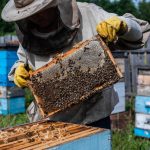Beekeeping, an age-old practice, has taken a modern twist. As you all move towards sustainable living, many are incorporating beekeeping into their urban lifestyles. However, space constraints often pose a challenge. But don’t fret. Indoor beekeeping is a viable solution. This article will guide you on how to set up an indoor beekeeping area with a safe external hive access.
Choosing the Right Beehive
The first step in setting up your indoor beekeeping area is selecting the right beehive. When it comes to indoor beekeeping, the observation hive is king. Unique and highly functional, it allows you to observe your bees at work without disturbing them.
Avez-vous vu cela : What’s the Best Strategy to Make a Small Bathroom Feel Luxurious and Spacious?
An observation hive is a glass or clear plastic hive that allows you to see the bees in action. It’s an excellent tool for educating children and adults alike about the fascinating lives of bees. These hives are generally smaller than traditional ones, usually containing between one to three frames. They can be wall-mounted, making them perfect for indoor use.
When choosing your hive, ensure it’s fitted with a queen excluder. This device will restrict the queen to the brood box, preventing her from laying eggs in the honey super. Since the queen is heavier than the worker bees, she won’t be able to pass through the excluder, but the workers will, ensuring honey production occurs in the right place.
Dans le meme genre : How Can You Implement a Greywater Recycling System for Home Landscaping?
Setting the Location and Access Point
After selecting the beehive, the next step is to decide where to place it. The location is crucial for successful indoor beekeeping. The hive should be in a place with minimal human traffic, preferably a spare room or a corner of your living area. Ensure you don’t place your hive near heaters or air conditioners, as extreme temperature changes can be harmful to your bees.
Your hive must have a safe external access point. This allows bees to come and go without any interference. A tube or conduit can be used to create an exit point from the hive to the outdoors. Make sure the tube is wide enough for the bees to pass through comfortably but not so large that it lets in drafts.
The exit point should preferably face south or southeast where it can catch the morning sun. This encourages the bees to get to work early. Also, ensure the exit is positioned away from your neighbor’s property and walking paths to prevent any unwanted encounters.
Furnishing the Hive with Frames
Now that you have your hive and a perfect location, it’s time to add frames to your hive. Frames give structure to the bees’ home and are where they will build their honeycomb.
Standard frames should be coated in beeswax to encourage the bees to start building. The number of frames you put in your hive will depend on its size. For a small observation hive, one to three frames will suffice.
You should also consider including foundationless frames. These allow bees to build their natural comb. It’s a great way to let your bees express their innate behaviors and creates a more organic environment within the hive.
Providing Water and Nourishment
Just like any living creature, bees need water to survive. Bees use water for cooling the hive, diluting stored honey, and for their brood. It’s essential to have a fresh water source near your hive. This could be a shallow basin with floating corks or stones for the bees to land on while they drink.
As for nourishment, bees gather pollen and nectar from flowers. However, during times when these resources are scarce, you’ll need to feed your bees. This can be done using a fondant or syrup made from refined white sugar and water.
Caring for Your Bees
Taking care of your bees means regular observation and maintenance. Check your hive regularly for signs of disease or parasites. Be on the lookout for mites, wax moths, and foulbrood. If you spot any of these issues, consult a local beekeeping association or extension service for advice.
Remember, bees will only sting when they feel threatened, so move slowly and calmly around your hive. If you’re worried about stings, invest in a bee suit for added protection.
Indoor beekeeping is a rewarding endeavor that not only gives you fresh honey but also contributes positively to the environment by providing a habitat for bees. With careful planning, observation, and care, you can maintain a thriving indoor bee colony.
Managing Seasonal Changes and Year-Round Beekeeping
Keeping bees indoors gives you the advantage of maintaining your hive year-round. However, it is still essential to understand and manage the seasonal changes that affect your bees.
During the winter months, honey bees cluster together in the hive to keep warm. They consume stored honey and generate heat by shivering. Indoor beekeeping eliminates the risk of freezing, but you must monitor your hive to ensure they have sufficient honey stores. If the honey is depleted, you can provide fondant or sugar syrup as additional nourishment.
In spring, the queen begins to lay more eggs, and the hive’s population increases. This is a good time to add more frames to your observation hive. Also, be sure to regularly monitor the hive for swarm cells, which indicate your colony is preparing to swarm, or split into two. If you spot any, you may need to remove them or consider setting up another hive to prevent overcrowding.
Summer is the peak season for nectar and pollen, so your bees will be busy. It’s essential to ensure the hive entrance is clear and the queen cage is secure to prevent the queen from leaving. Regularly check your observation hive to ensure everything is running smoothly.
Autumn is when your bees will prepare for winter. They will reduce their hive population and begin to build up their honey stores. At this time, you might even be able to harvest some honey. However, remember to leave enough for the bees to survive the winter.
Conclusion: The Reward of Indoor Beekeeping
Indoor beekeeping with a safe external hive access can be a fascinating and rewarding experience. It offers a unique opportunity to observe the intricate workings of a honey bee colony up close without disrupting their natural behaviors. Whether your motivation is to harvest your own honey, boost pollination in your local area, or simply to contribute to the preservation of these vital pollinators, indoor beekeeping can be an enriching endeavor.
However, it’s essential to remember that beekeeping requires commitment and responsibility. Your bees will depend on you year-round for their survival. From choosing the right observation hive to setting the location and access point, furnishing the hive with frames, providing water and nourishment, and caring for your bees, each step is crucial.
Remember, the wellbeing of your small hive does not only rely on your hands but also on your understanding and respect for these extraordinary creatures. As you delve deeper into the world of beekeeping, you will learn more about these remarkable insects and their crucial role in our ecosystem.
So, what are you waiting for? Find your perfect place beehive, prepare your nuc box, set up your water source, and let’s keep bees! With patience and care, you’ll soon have thriving nucleus colonies buzzing with activity, a hive filled with honey, and a newfound appreciation for these incredible pollinators.
















